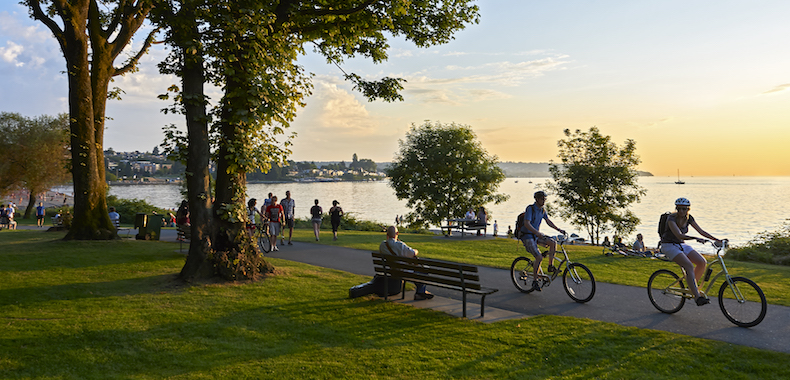What is Walkability?

How often do you walk around your neighborhood? If it were easier or more enjoyable, would you do it more? What about if there were landmarks or shops or parks closer to you? These are all questions that walkability aims to answer. But what is walkability? A home’s or neighborhood’s walkability score is becoming a more and more important part of real estate. Understanding this interesting attribute can help to understand what buyers are looking for, and whether walkability will add—or detract from—your home value.
What is Walkability?
Walkability is a relatively new metric measured by city planners, researchers, and real estate experts. But what walkability actually is can be debatable. Different groups are concerned with different aspects of walkability, but in general walkability can be summed up with the following:
- Safe: Residents feel safe walking in the neighborhood. This includes being safe from crime as well as safe from traffic.
- Enjoyable: The walking paths, including sidewalks or designated trails, are well-maintained. The paths are not very noisy or polluted.
- Traversable: Either by connecting to public transit or simply by being close by, residents can realistically walk to a destination, such as a park, shop, or restaurant.
Obviously, this will be different for different people. Comfortable walking distances and speeds vary from person to person. What might be a safe neighborhood for one person might not be safe for another. To accurately measure what walkability is and whether or not a given neighborhood is walkable or not, it’s useful to track against objective measurements. Average crime, average accidents involving pedestrians, and the number of businesses or parks in a square mile are all useful metrics.
Why Walkability Matters
Prospective home buyers are increasingly looking for walkable neighborhoods. 56% of Millennials, currently the largest home-buying segment, as well as 46% of Baby Boomers, prefer walkable neighborhoods. A number of factors contribute to this, including:
- Environmental concern: a growing concern for carbon emissions and air quality has people looking for ways to cut their carbon footprint. With transportation contributing approximately 29% of carbon emissions in America, driving less is a good place for many to start.
- Health concerns: Less than one in four Americans gets the recommended amount of daily exercise. A walkable neighborhood makes it easier to get more exercise.
- Social concerns: Though social media has enhanced electronic connections, finding like-minded people to socialize with or date has become more difficult across age groups and lifestyles. Being able to walk to parks, community centers or other social areas makes it easier to connect with others.
Can Walkability Increase My Home Value?
How much walkability affects your property’s value depends largely on your key buyers. If your property is ideal for retirees or young couples that want to walk to nearby shops and amenities, walkability can have a notable effect on your home value. However, if your home is far removed from the city center, its remote location might appeal to those looking for some peace and quiet.
Generally, good walkability will increase your property value. Property listing website RedFin estimates that even a one point increase on their Walk Score scale can increase property value by nearly 1%. If you’re home has 10 more Walk Score points than a home of comparable size, your home may be worth as much as 10% more.
The World’s Most Walkable Cities
Comparing the most walkable cities in the world, in America, and in Michigan, there are a lot of differences. However, there are also a lot of similarities. Though modes of transportation and the appearances of cities vary across cultures and geography, the functionality of the cities are very similar. You’ll notice that all of these cities have safe walking paths, that residences and businesses mingle, and that they have reliable public transportation.
Most world’s most walkable cities, according to Frommer’s travel website.
- Florence, Italy: With breathtaking scenery and historic landmarks aplenty, as well as safe, well-maintained bridges and pathways, and multiple public transit services, walking around Florence is easy and enjoyable.
- Paris, France: Another historic city, Paris was built around walking. Residents and city planners have modernized the city with care to ensure it is still safe, enjoyable and easy to walk.
- Dubrovnik, Croatia: This is a hidden gem for most Americans. Like the previous two, Dubrovnik’s historic roots, beautiful architecture, and carefully maintained landmarks make it a beautiful city to walk in.
- New York City, USA: New York City is America’s most walkable city, as well as its most populous city. With an active rail and bus system connecting five walkable boroughs, it’s easy, and generally preferable to get around this city without a car.
- Vancouver, Canada: Dedicated walking and bike trails alongside the coast, as well as active bus, train, and even water bus routes give Vancouver, Canada a high walkability score.
These cities are all very different, yet they’re all very walkable. Some are historic—Florence was founded over 2,000 years ago—and others are relatively new—most of Vancouver was built in the last 100 years. Some are very populous—New York City hosts over 8.6 million residents—while others are much smaller—Dubrovnik has only about 43,000 (for comparison, East Lansing alone has about 48,000).
If you’re wondering about your walkability score, consider how often you walk around your neighborhood, and what you find when you do. If you feel safe, the walk is enjoyable, and you can arrive at shops, parks, community centers, or other amenities without much trouble, your community is probably very walkable. Point this out to your Realtor if you’re considering selling. If you’re considering buying, consider walkability as you look for a home.


